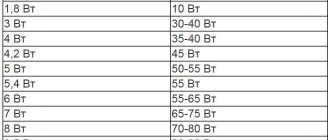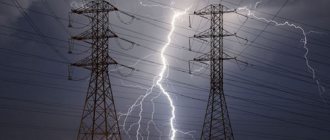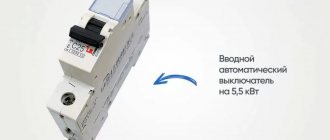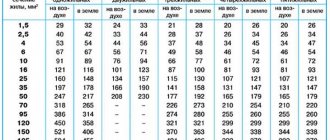What is specific installed capacity?
According to GOST R 19431-84
,
the installed power of an electrical installation
is the highest active electrical power with which the electrical installation can operate for a long time without overload in accordance with the technical specifications or equipment passport.
In this case - in relation to lighting - this is the total rated power of all lamps that are part of the lighting installation
.
Specific installed power
- according to
SP 52.13330.2016
- is
the installed power of artificial lighting in a room, related to the usable area
. In simple terms, the specific installed power shows how many watts of electrical power will be consumed by the artificial lighting system per 1 square meter of illuminated area. To calculate its value, you need to add up all the rated powers of the lamps installed in the room (these values are always indicated in the device passport) and divide the resulting number by the area of the room.
For outdoor lighting, the concept of relative power density of a utility lighting installation is used. The calculation method in this case is a little more complicated than for premises. Details can be found in Appendix M to SP 52.13330.2016
. Specialized software - DIALux, for example - usually calculates this parameter automatically. The corresponding standard values for lighting streets and roads are given in the corresponding article and will not be considered here.
It is also worth noting that all well-made LED lighting systems fall within the values given here with a margin. At least among all the calculations made by our specialists recently, there was not a single one in which the specific installed power was higher than the maximum permissible value. This is achieved due to high luminous efficiency, which is characteristic to varying degrees of all LED lamps.
The values given in the tables must be calculated taking into account the energy consumption of ballasts and lighting control systems, if any, are used.
Calculation of electric lighting using the specific power method. Continuation
Date: August 9, 2010 | Category: Articles, Artistic lighting Tags: Lighting, Lighting calculation, Lighting system This material was prepared by specialists. Do you need electrical installation or electrical measurements? Call us! Beginning of the article “Calculation of electric lighting using the specific power method. Start"
Incandescent lamp voltage. In the tables, the specific power is given for incandescent lamps designed for a voltage of 200 V. When using 127 V incandescent lamps in a lighting installation, it is necessary to multiply the specific power value found in the table by 0.68.
Articles in the series “Methods for calculating electric lighting”:
- Introduction.
- Luminous flux utilization factor method.
- Calculation of electric lighting using the specific power method. Start.
- Calculation of electric lighting using the specific power method. Continuation
Lamp efficiency. In all tables, power density values are given for lamps whose efficiency is conventionally 100%. Thus, in order to find out the real value of Pud for the luminaires you have chosen, you need to divide the table value of the specific power by their efficiency, presented in fractions of a unit.
For example, if the efficiency of the lamp is 60%, and the tabulated specific power is 2.9 W/m², then you can determine the real Pud by making the following calculation: 2.9 / 0.6 = 4.83 W/m² As can be seen from the above example, The lower the efficiency of the lamp, the greater the specific power that will be needed to achieve the required illumination.
Luminous flux utilization factor. To determine Pud, it is enough to perform a simplified calculation of the utilization factor that does not take into account the shape of the illuminated room:
Ƞ = 0.48√S / hр (at A/B ≤ 3); Where S is the area of the room; hр is the height of the lamp suspension above the working surface.
The area of the illuminated room S is also important when determining the specific power of the lighting installation according to the tables.
Now that all the quantities that may be needed to determine Pud in the tables have been described, let’s consider the entire sequence of calculation using the specific power method:
| Incandescent lamp, W | Luminescent, W | LED, W |
| 15 | 3 | 1 |
| 35 | 7 | 3 |
| 50 | 11 | 5 |
| 70 | 15 | 7 |
| 90 | 19 | 9 |
| 120 | 25 | 12 |
Expert opinion
It-Technology, Electrical power and electronics specialist
Ask questions to the “Specialist for modernization of energy generation systems”
Calculation and installation of LED floodlights with a built-in motion sensor - RMNT - February 22 - 43272243446 - MirTesen media platform To provide comfortable lighting for a parking area of 120 m2, you will need two LED floodlights, each with a power of 30 W. Ask, I'm in touch!
Values for industrial premises
Maximum permissible specific installed power of artificial lighting in industrial premises
| Illumination on the working surface, lux | Room index | Maximum permissible specific installed power, W/m² |
| 750 | 0,6 | 30 |
| 0,8 | 26 | |
| 1,25 | 19 | |
| 2 or more | 15 | |
| 500 | 0,6 | 20 |
| 0,8 | 17 | |
| 1,25 | 12 | |
| 2 or more | 10 | |
| 400 | 0,6 | 15 |
| 0,8 | 13 | |
| 1,25 | 10 | |
| 2 or more | 8 | |
| 300 | 0,6 | 12 |
| 0,8 | 10 | |
| 1,25 | 8 | |
| 2 or more | 6 | |
| 200 | 0,6 — 1,25 | 9 |
| 1,25 — 3,0 | 6 | |
| More than 3 | 5 | |
| 150 | 0,6 — 1,25 | 7 |
| 1,25 — 3,0 | 5 | |
| More than 3 | 4 | |
| 100 | 0,6 — 1,25 | 5 |
| 1,25 — 3,0 | 3 | |
| More than 3 | 2,5 |
23
HYGIENIC ASSESSMENT OF ARTIFICIAL LIGHTING OF PREMISES AND METHODS OF DETERMINATION
Physical characteristics of artificial lighting
1. Artificial lighting (as well as natural) is characterized by:
- luminous intensity (I) – the power of light sources, which is determined in candelas (Cd). This is the luminous intensity that generates in a certain direction monochromatic radiation with a frequency of 540 1012 Hz, the luminous energy of which in this direction is 1/683 W/steradian;
- luminous flux (F) - spatial density of light radiation, the unit of which is lumen (lm) - luminous flux emitted by a single source at a luminous intensity of 1 cd in a solid angle of 1 steradian (spatial angle in the form of a cone with the vertex in the center of a sphere that cuts on the surface of this sphere is a surface whose area is equal to the square of the radius of the sphere);
- illumination (E) – surface luminous flux density E = F/S, where: S – area of the lighting surface, m2. Illumination unit - lux (lx) - illumination of a surface area of 1 m2 with a luminous flux of 1 lm;
- brightness (B) – the intensity of light that is emitted or reflected from a unit area in m2 in a certain direction: B = I / (dS*cos) cd/m2, where: dS cos – visible area of the luminous surface; – the angle between the direction of propagation of the luminous flux and the normal to the luminous surface. The unit of brightness is cd/m2 - the brightness of a luminous surface (generating or reflecting) from an area of 1 m2 at a luminous intensity of 1 cd;
- reflection coefficient () - the ratio of the reflected light flux (Frev.) to the flux that falls on the surface (Fpad.), is determined by the formula = Fref./Fpad. The value for fresh snow is 0.9, for white paper – 0.7, for untanned skin – 0.35.
- light transmission coefficient () – the ratio of the luminous flux that passed through the medium (Fpr) to the luminous flux that falls on this medium (Fpad): = Fpr./Fpad. This coefficient allows you to evaluate the quality and cleanliness of window glass and lighting fixture glass.
- luminosity (M) – surface density of luminous flux in lm that is emitted (or reflected) from an area of 1 m2 (lm/m2).
2. Visual functions
- visual acuity (discrimination acuity) is the ability of the visual analyzer to distinguish the smallest details of an object. Defined by the smallest angle at which two adjacent points are distinguished as separate. Conventionally, it is believed that visual acuity is equal to one radial minute. The sharpness of discrimination increases in proportion to the increase in illumination up to 130-150 lux, and with a further increase in illumination this growth slows down;
- contrast sensitivity is the ability of the visual analyzer to perceive the minimum difference in brightness of the object under study and the background. It is greatest at illumination of 1000 -2500 lux;
- speed of visual perception - the time during which the awareness of the details of the object being viewed occurs. This speed increases to an illumination of 150 lux, and then this increase decreases somewhat disproportionately to the increase in illumination;
- visibility is an integral function of the visual analyzer, which takes into account its main functions - visual acuity, contrast sensitivity, speed of visual perception;
- stability of clear vision - the ratio of the time of clear vision of an object to the total time of viewing the detail. Physiologically, this function of the visual analyzer is based on the destruction of visual purple under the influence of light energy and the formation of a protective black pigment in those areas of the retina where the image is brighter. This function reaches optimal values at illumination levels of 600-1000 lux. Its decrease indicates the development of fatigue of the visual analyzer;
- function of color difference (perception). White, black, gray colors are achromatic, characterized only by brightness and intensity of light flux. Chromatic colors are monochromatic, characterized by brightness and chromaticity. Vision is most sensitive to the yellow-green part of the visible spectrum, least sensitive to violet radiation. In twilight and artificial lighting (especially with incandescent lamps), the color sensitivity of the visual analyzer is reduced and distorted.
- adaptation - the ability of the visual analyzer: a) to reduce its sensitivity when moving from low to high illumination (light adaptation), which occurs quite quickly (in 2-3 minutes) and is due to the transformation of visual purple into a protective black pigment in the retina; b) increase this sensitivity when moving from high to low illumination (dark adaptation), which lasts much longer - up to 40-60 minutes and is due to the restoration of visual purple in the retina.
- accommodation - the ability of the eye to regulate visual acuity depending on the distance to the object of viewing and lighting due to changes in the refraction of light in the optical system of the eye, mainly due to the curvature of the lens. When illumination decreases below 100-75 lux, this curvature increases; the object being viewed must be brought closer to the eyes. Insufficient illumination contributes to overstrain of the accommodation system, the development of fatigue and overwork of the visual analyzer, and in an unformed visual analyzer (children, adolescents) - the development of myopia, especially when there is an innate predisposition to this.
- The critical frequency of blinking is determined by the times during which traces of images are stored in the visual analyzer: the image of an object that has disappeared from the field of view remains visible for another moment, depending on the brightness of this object. The physiological basis of this function of vision is the very processes of destruction and restoration of visual purple. The greatest invention of mankind, cinema, is based on this function of vision. Frequent changes in frames (25 per second), close to the configuration of objects and screen dimming ensure continuity and dynamics of the image.
Sources of artificial lighting – electric and non-electric. The latter include kerosene stoves, carbide lamps, candles, and gas lamps. Their use in our time is limited - in emergency situations, in field conditions, etc.
Electric sources of artificial lighting are divided into arc lamps (in spotlights, jupiters), incandescent lamps, gas lighting, and fluorescent lamps.
The disadvantage of incandescent lamps is the shift of the spectrum towards the yellow-red side, distortion of the color sensation, and the blinding effect of direct rays.
Fluorescent lamps have a spectrum similar to daylight, with modifications that depend on a phosphor that coats the inner surface of the glass tube and transforms the ultraviolet glow of mercury vapor in the tube into visible light. There are fluorescent lamps (LD), white light (WL), warm white light (WLT), etc.
The disadvantage of fluorescent lamps is the stroboscopic effect - the blinking of moving objects.
One of the disadvantages of both direct sunlight and bright artificial light sources is their ability to cause glare. We protect ourselves from bright sunlight by using curtains, blinds on windows, tinted glass, and using safety glasses.
To protect against the glare of artificial lighting sources, lighting fixtures are used (which, by the way, also performs aesthetic functions).
From the point of view of the formation of the luminous flux, there are 5 types of lighting fixtures (Fig. 5.1):
- – direct light, when the entire light flux is directed into one hemisphere (table lamp with an opaque lampshade, spotlight, “Jupiters”, which are used in photography and filming);
- uniformly diffused light (matte or milky white ball);
- reflected light (when a lamp with an opaque lampshade directs the luminous flux into the upper hemisphere. In this case, the light is reflected from the ceiling and scattered into the lower hemisphere);
- directionally diffused light, when the main light flux is directed into the lower hemisphere through a hole in the lampshade, and part of it is scattered into the upper hemisphere through a lampshade made of frosted or milky-white glass or plastic;
- reflected-scattered light, when the main light flux is directed to the upper hemisphere and reflected from the ceiling, and part is scattered into the lower hemisphere through a lampshade made of frosted or milky-white glass or plastic.
The permissible amount of blindness in the workplace is:
- with І, ІІ category of visual work – 20 cd/m2;
- with III, IV, V categories of visual work – 40 cd/m2;
- with VI, VII categories of visual work – 60 cd/m2.
Scheme for assessing artificial indoor lighting.
Descriptive data:
- name and purpose of the premises;
- lighting system (local, general, combined);
- number of lamps, their type (incandescent, fluorescent and others);
- their power, W;
- type of lighting fixtures and, in connection with this, the direction of the light flux and the nature of the light (direct, uniformly diffused, directionally diffused, reflected, diffusely reflected);
- height of suspension of lamps above the floor and work surface;
- area of the illuminated room;
- reflectivity (brightness) of surfaces: ceilings, walls, windows, floors, equipment and furniture.
Determination of illumination using the “Watt” calculation method:
- a) measure the area of the premises, S, sq. m;
- b) determine the total power W generated by all lamps;
- c) calculate the specific power, W/sq. m;
- d) in Table 1 of the minimum horizontal illumination values, find the illumination at a specific power of 10 W/sq. m;
- e) for incandescent lamps, illumination is calculated using the formula:
where P – specific power, W/sq. m;
etab. – illumination at 10 W/sq. m, (Table 1);
K is the safety factor for residential and public premises, which is equal to 1.3.
Table 1. Values of minimum horizontal illumination Etab. at a specific power (P) of 10 W/sq. m.
| Power of electric lamps, W | Direct light | Half-reflected light | ||
| voltage, V | ||||
| 100……127 | 220 | 100……127 | 220 | |
| 40 | 26 | 23 | 16,5 | 19,5 |
| 60 | 29 | 25 | 25 | 21 |
| 100 | 35 | 27 | 30 | 23 |
| 150 | 39,5 | 31 | 34 | 26,5 |
| 200 | 41,5 | 34 | 35,5 | 29,5 |
| 300 | 44 | 37 | 38 | 32 |
| 500 | 48 | 41 | 41 | 35 |
The formula can be used to calculate illumination if the lamps are of the same power. For lamps of different power, the calculation is carried out separately for each lamp power, and the results are added. The illumination value found by the “Watt” method is compared with standard values (Table 2).
Table 2. Standards for general artificial lighting (SNiP II-69-78 and SNiP II-4-79)
| Room | Lowest illumination, lux | |
| Fluorescent lamps | Incandescent lamps | |
| Rooms and kitchens of residential buildings | 75 | 30 |
| Study rooms | 300 | 150 |
| Technical drawing rooms | 500 | 300 |
| School workshops | 300 | 150 |
| Reading rooms | 300 | 150 |
| Operating room, sectional | 400 | 200 |
| Delivery, dressing, procedural | 500 | 200 |
| Preoperative | 300 | 150 |
| Office of surgeons, obstetricians-gynecologists, pediatricians, infectious disease specialists, dentists | 500 | 200 |
| Functional diagnostics room | – | 150 |
| X-ray room | – | 150 |
| The glow of children's wards for newborns, postoperative wards | 150 | 75 |
For fluorescent lamps with a specific power of 10 W/sq. m, the minimum horizontal illumination is 100 lux. For other specific powers, the calculation is carried out according to the proportion.
For industrial premises, according to SNiP II-4-79, all types of work are divided into 7 categories, based on the linear dimensions of the smallest recognition object with which a worker works at a distance of 0.5 m from the eye. The first 5 digits are divided into 4 subcategories (a, b, c, d), based on the contrast between the recognition object and the background. For example, for particularly precise visual work (1st category, object size less than 0.1 mm), the illumination of the workplace should be: with little contrast with the background - 1500 lux; with medium – 1000 lux, with large – 400 lux. When working with low precision (4th category, object size 1.0-10 mm), respectively, 150, 100, 75 lux.
The proposed calculation method is not absolutely accurate, since it does not take into account the illumination of each point, the location of lamps and other factors that affect illumination, but is widely used to estimate the illumination of classrooms, hospital wards, and the like.
To determine the illumination at a separate workplace in a room, multiply the specific power of the lamps (P) by the coefficient (e), which shows how many lux the specific power of 1 W/sq.m gives. m: E = P x e. This coefficient is for a room with an area of 50 square meters. m with lamps up to 110 W is 2, 110 W and more - 2.5 (Table 3), for fluorescent lamps - 12.5.
Table 3. Value of coefficient e.
| Lamp power, W | Network voltage coefficient, V | |
| 110, 120, 127 | 220 | |
| up to 110 | 2,4 | 2,0 |
| 110 and more | 3,2 | 2,5 |
Determining illumination in the workplace using a lux meter.
Determination of horizontal illumination in the workplace is carried out using a lux meter (see topic No. 4, Appendix 2). Since the device is calibrated for measuring the illumination created by incandescent lamps, a correction factor of 0.9 is introduced for fluorescent daylight lamps (LD); for white lamps (LB) – 1.1; for mercury (LDR) – 1.2.
If the determinations are carried out during the day, then you should first determine the illumination created by mixed lighting (artificial and natural), then with the artificial lighting turned off. The difference between the obtained data will be the amount of illumination created by artificial lighting.
The uniformity of illumination is determined by the “envelope method” - the illumination is measured at 5 points in the room and assessed by calculating the illumination unevenness coefficient (the ratio of the minimum to maximum illumination at two points, each separated by a distance of 0.75 m, if the uniformity of illumination in the workplace is determined, or at a distance of 5 m, if the uniformity of lighting in the room is determined).
Calculation of the brightness of the working surface is determined by the formula:
where, I – brightness, cd/sq. m;
E – illumination, lux;
K – surface reflectance coefficient (white – 0.7; light beige – 0.5; brown – 0.4; black – 0.1).
The permissible brightness of general lighting fixtures for residential and public premises is given in Table 4.
Table 4. Permissible brightness of general lighting fixtures for residential and public premises.
| Acceptable brightness value, cd/sq. m | ||
| for incandescent lamps | for fluorescent lamps | |
| Main premises of residential and public buildings. | 15000 | 5000 |
| Classrooms, classrooms, auditoriums, reading rooms, libraries. | 5000-8000 | 5000-8000 |
| Doctor's office. | 15000 | 5000 |
| Hospital wards and special rooms for children's institutions and boarding schools. | 5000 | 5000 |
To create sufficient and uniform lighting and protect vision from glare, the height of the suspension and the placement of general light fixtures in the horizontal and vertical planes of the room are important. For general and combined lighting, general lighting lamps are placed evenly in the horizontal plane of the ceiling (if necessary to create sufficient illumination in all points of the room), or concentrated and localized (to create higher illumination in some areas of the room).
Placement of lamps above floor level - the height of the suspension (in order to limit the glare they create) must be no less than the values indicated in Table 5.
The best lighting conditions are created by determining the ratio of the distance between the lamps in the horizontal plane (L) to the height of their suspension above the place being examined (H). These ratios were established based on the determination of light distribution curves of different types of lamps, their optimal values are presented in Table 6.
Table 5. Minimum height for hanging general lighting fixtures above the floor (m).
| Characteristics of the lamp | Incandescent lamps | Fluorescent lamps (depending on the quantity in the lamp) | ||
| power 200 W or less | power more than 200 W | 4 or less | more than 4 | |
| Direct light fixtures with diffuse reflectors: | ||||
| a) protective angle in the range from 100 to 300; | 3 | 4 | 4 | 4,5 |
| b) protective angle is greater than 300 | not limited to | – | 3 | 3,5 |
| Ambient light luminaires with diffuser transmittance: | ||||
| a) less than 55%; | 2,5 | 3 | 2,6 | 3,2 |
| b) from 55 to 80% | 3 | 4 | 3,5 | 4,0 |
Table 6. Optimal ratio of the distance between the lamps and their height above the surface under study (L/H)
| Lamp type | L/N |
| “Universal” without shade, with opal shade | 1,8-2,5 |
| “Lucetta” direct light, enameled deep emitter | 1,6-1,8 |
| Enameled deep emitter | 1,2-1,4 |
| Ball of milky white silicate or organic glass | 2,3-3,2 |
| Note: The first number is the optimal placement of lamps; The second number is the permissible placement of lamps. | |
Values for public buildings
Maximum permissible specific installed power of artificial lighting in public buildings
| Illumination on the working surface, lux | Room index | Maximum permissible specific installed power, W/m² |
| 500 | 0,6 | 23 |
| 0,8 | 20 | |
| 1,25 | 18 | |
| 2 or more | 15 | |
| 400 | 0,6 | 20 |
| 0,8 | 16 | |
| 1,25 | 14 | |
| 2 or more | 12 | |
| 300 | 0,6 | 18 |
| 0,8 | 14 | |
| 1,25 | 12 | |
| 2 or more | 10 | |
| 200 | 0,6 — 1,25 | 14 |
| 1,25 — 3,0 | 8 | |
| More than 3 | 6 | |
| 150 | 0,6 — 1,25 | 10 |
| 1,25 — 3,0 | 8 | |
| More than 3 | 7 | |
| 100 | 0,6 — 1,25 | 5 |
| 1,25 — 3,0 | 3,5 | |
| More than 3 | 3 |
Minimum recommended values of luminous efficiency of devices
The concept of specific installed power is closely related to the concept of luminous efficiency
lighting fixtures.
If a lamp has a low luminous efficiency, a lighting installation designed on its basis may go beyond the regulated specific installed powers. Therefore, here we offer another table for your reference, which shows the minimum recommended values of luminous efficiency of devices used in modern lighting systems. Recommended luminous output of devices depending on their color rendering index
| Source type | Luminous output of lighting devices, lm/W, no less, with minimum permissible color rendering indices Ra | |||
| ≥80 | ≥60 | ≥40 | ≥20 | |
| Lighting devices for general indoor lighting | ||||
| Lighting devices with LED light sources and LED modules | 90 | 100 | — | — |
| Lighting devices with fluorescent light sources | 50 | 40 | — | — |
| Lighting devices with metal halide light sources | 55 | 50 | — | — |
| Lighting fixtures with high pressure sodium lamps | — | 50 | 60 | — |
| Lighting devices for illuminating work areas outside buildings | ||||
| Lighting devices with LED light sources and LED modules | 90 | 100 | — | — |
| Lighting devices with metal halide light sources | — | — | 50 | 50 |
| Lighting fixtures with high pressure sodium lamps | — | — | 50 | 50 |
| Lighting devices with fluorescent light sources | 40 | 50 | — | — |
| Lighting devices for external utilitarian lighting of residential areas | ||||
| Lighting fixtures with LED lamps and modules | 90 | 100 | — | — |
| Lighting devices with metal halide light sources | — | — | 50 | 50 |
| Lighting fixtures with high pressure sodium lamps | — | — | 50 | 50 |











